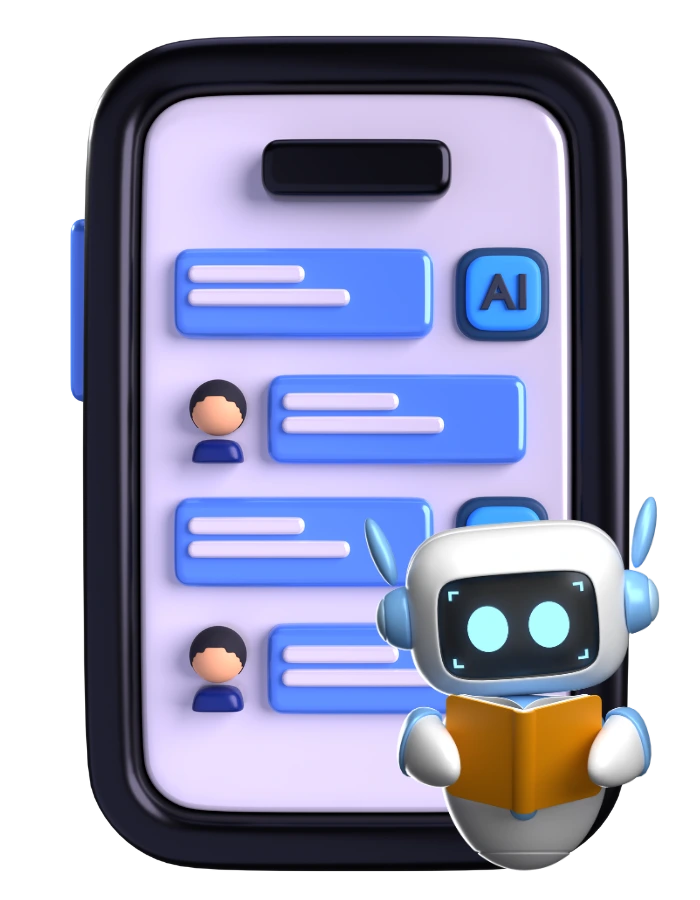In the last few years, generative AI adoption has accelerated at an unprecedented pace. Businesses across the world—from agile startups to global enterprises—are leveraging AI to automate tasks, enhance productivity, improve customer experience, and gain a competitive advantage. However, one common misconception persists: AI is only for large enterprises with deep pockets.
From our experience at Inceptive Technologies, working closely with organizations across industries, the truth is very different. Small and mid-sized companies (SMBs) can adopt AI quickly, affordably, and strategically, without heavy investments or complex infrastructures. The real challenge is not budget—it’s understanding how to start, where to focus, and how to scale responsibly.
In this blog, we are sharing practical insights, experience-driven strategies, and proven adoption frameworks that small and mid-sized businesses can implement immediately. Whether you are exploring AI for automation, customer engagement, predictive analytics, or internal process optimization, the following guide will help you confidently move forward.

Why Generative AI Is Now Accessible to Small and Mid-Sized Companies
Just a few years ago, adopting AI required massive data warehouses, expensive computing resources, and a team of data scientists. Today, the landscape has changed. Cloud platforms, open-source models, and pay-as-you-use AI APIs have made AI cost-effective, scalable, and simple to deploy.
Here are the main reasons SMBs can adopt AI without huge budgets:
1. Availability of Low-Cost AI Tools and APIs
Tools like ChatGPT, Claude, Gemini, Copilot, and multiple open-source LLMs provide enterprise-grade capabilities at minimal cost. Companies can start small and scale later.
2. No Need for In-House Infrastructure
Cloud-based AI tools eliminate the need for servers, heavy storage, and expensive maintenance.
3. Pre-Trained Models Reduce Development Cost
Generative AI tools come with pre-built capabilities like text generation, code generation, image creation, forecasting, and summarization—reducing project time drastically.
4. High ROI with Small Investments
Automating repetitive tasks alone can save thousands of productive human hours annually—something we’ve witnessed firsthand with our clients.
5. Growing Marketplace of AI Integrations
CRMs, ERPs, HRMS platforms, and project management tools now include AI extensions that are affordable and easy to enable.
In other words, AI affordability has democratized innovation.

Step-by-Step Guide: How SMBs Can Adopt Generative AI With Minimal Investment
Step 1: Start with a Low-Risk, High-Impact Use Case
Instead of trying to “implement AI everywhere,” begin with one or two functions that give quick wins.
From our experience, the best entry-level AI use cases for SMBs include:
-
AI-powered customer support automation
-
Intelligent document generation
-
Marketing content automation
-
Social media scheduling and content creation
-
Sales outreach optimization
-
AI-driven data summarization
-
Workflow automation using AI
-
Lead qualification and CRM enhancement
Focusing on small wins builds confidence, drives awareness, and accelerates internal adoption.
Step 2: Use No-Code or Low-Code AI Platforms
Small businesses don’t need to hire large technical teams. Tools like:
-
Zapier AI
-
Notion AI
-
Make.com
-
Microsoft Power Automate AI Builder
-
HubSpot AI
-
Airtable AI
These no-code tools allow teams to automate workflows, integrate systems, and deploy AI-driven processes with minimal technical expertise and minimal cost.
We have helped several clients integrate such tools into their daily operations, enabling significant gains with almost zero development cost.
Step 3: Leverage Open-Source and Freemium AI Models
Open-source AI models like Llama 3, Mistral, GPT-Neo, and Stable Diffusion provide powerful generative capabilities without licensing fees. Businesses can run them locally or in the cloud at a fraction of the cost.
For example:
-
Customer chatbots
-
Email automation
-
Knowledge base creation
-
HR document generation
-
Internal content optimization
Using open-source models drastically reduces operational costs and ensures flexibility.
Step 4: Integrate AI Into Existing Tools Instead of Building Custom Platforms
Instead of building your own AI application from scratch—which can be expensive—embed AI into your existing tools. Most platforms today offer plug-and-play AI integration.
For example:
-
AI in Slack for instant knowledge retrieval
-
AI in Jira for task creation and sprint planning
-
AI in Figma for auto-design
-
AI in CRM tools for lead scoring and forecasting
-
AI in email tools for personalization
This approach eliminates development time and gives your team immediate value.
Step 5: Use AI for Internal Knowledge and Process Automation
Many companies overlook internal operations as a potential AI use case. However, this is where the highest ROI often lies.
Small businesses can automate:
-
Standard Operating Procedure (SOP) generation
-
Meeting notes and action item extraction
-
Contract review and analysis
-
Automated reporting
-
Employee onboarding workflows
-
Internal chatbot for company knowledge
Internal automation reduces manual effort and eliminates repetitive tasks—allowing teams to focus on high-value work.
Step 6: Train Your Team to Use AI Effectively
Adoption doesn’t come from tools; it comes from people using the tools.
A minimal investment in AI training can create exponential returns.
SMBs should consider team training on:
-
Prompt engineering
-
AI-based decision-making
-
Using AI responsibly
-
Understanding AI limitations
-
Ensuring data privacy
We have seen companies unlock 2–3x productivity gains simply by teaching employees how to use AI tools properly.
Step 7: Focus on Data Privacy and Responsible AI
Even small companies must maintain ethical and secure use of AI. Fortunately, cloud providers and AI tools now offer built-in compliance features at affordable rates.
Key considerations:
-
Do not upload confidential information to unsecured tools
-
Use enterprise or business versions when needed
-
Ensure AI outputs are reviewed by humans
-
Keep sensitive customer data anonymized
-
Follow compliance standards relevant to your industry
Responsible AI builds trust and prevents long-term risks.
Step 8: Scale Your AI Adoption Gradually
After achieving quick wins, companies can expand AI use cases to other departments:
-
AI for finance forecasting
-
AI for supply-chain optimization
-
AI-driven business intelligence
-
AI for HR candidate screening
-
AI-powered customer analytics
-
Generative AI for product design
Scaling AI in phases helps maintain cost efficiency while ensuring meaningful transformation.

Affordable Generative AI Use Cases for SMBs Across Different Functions
Below are practical scenarios where small and mid-sized businesses can adopt AI without large budgets:
1. Sales
-
Automated outbound email writing
-
Lead scoring using AI prediction models
-
CRM data enrichment
-
Sales call summarization
AI can help sales teams save hours every week and close more deals.
2. Marketing
-
SEO-friendly blog creation
-
Social media content generation
-
AI-powered ad copy creation
-
Competitor analysis using AI tools
Marketing teams can produce more content in less time, improving brand visibility.
3. Customer Support
-
Chatbots for instant responses
-
Ticket classification and routing
-
Customer sentiment analysis
-
AI-driven self-help portals
This improves response time and reduces dependency on large teams.
4. Operations
-
Automated reporting
-
Inventory forecasting
-
Vendor management updates
-
Workflow automation
Operations become more accurate and predictable.
5. HR and Recruitment
-
Resume screening
-
Job description creation
-
Employee onboarding automation
-
Policy drafting
HR teams can cut down several manual hours with AI assistance.
Common Mistakes SMBs Should Avoid in AI Adoption
Through our experience, we have observed a few avoidable pitfalls:
1. Trying to Implement AI Everywhere at Once
Start small. Identify the tasks that deliver maximum impact.
2. Buying Expensive Tools You Don’t Need
Many affordable or free AI alternatives exist.
3. Ignoring Data Quality
Poor data leads to poor AI performance.
4. No Clear AI Strategy or Roadmap
Set clear goals, metrics, and milestones.
5. Not Training Employees
Without proper training, successful adoption becomes challenging.
Why the Time Is Perfect for SMBs to Adopt Generative AI
Generative AI today is more accessible, economical, and advanced than ever.
Some powerful reasons SMBs should begin now:
-
Early adoption equals competitive advantage
-
Cost of automation is at its lowest
-
Tools are simpler and intuitive
-
AI capabilities are improving monthly
-
Even limited budgets can create significant value
Inceptive Technologies has witnessed firsthand how even a few hours a week of AI-assisted automation generates substantial business transformation across teams.
The companies that embrace AI today will lead their markets tomorrow.
FAQs
1. Can small businesses really afford generative AI?
Yes. With cloud AI tools, open-source models, and subscription-based platforms, small businesses can start with minimal investment. Most AI tools cost less than a monthly software subscription.
2. What are the best generative AI use cases for SMBs?
The most effective entry-level use cases include customer support automation, marketing content creation, internal documentation generation, workflow automation, and sales assistive tools.
3. Do SMBs need developers to adopt generative AI?
Not always. Many no-code and low-code AI tools allow businesses to automate processes without engineering teams. Developers are only needed for more advanced custom solutions.
4. Is generative AI safe for handling company data?
Yes, if used responsibly. Companies should choose enterprise-grade AI tools, avoid sharing sensitive data with unsecured services, and follow proper compliance guidelines.
5. How long does it take for SMBs to see results from AI adoption?
Most small businesses experience productivity gains within the first 2–4 weeks, especially when starting with simple automation tasks or content-related activities.
Resource Center
These aren’t just blogs – they’re bite-sized strategies for navigating a fast-moving business world. So pour yourself a cup, settle in, and discover insights that could shape your next big move.
How Small and Mid-Sized Companies Can Adopt Generative AI Without Huge Budgets?
In the last few years, generative AI adoption has accelerated at an unprecedented pace. Businesses across the world—from agile startups to global enterprises—are leveraging AI to automate tasks, enhance [...]
Google Launches Gemini 3: Next-Generation AI Model with Advanced Coding Capabilities and Record-Breaking Benchmarks
In the fast-evolving world of artificial intelligence, Google has once again raised the bar with the launch of Gemini 3, its latest and most advanced large language model (LLM). [...]
What’s Next in Generative AI — Beyond Text and Images: Video, Code, Multimodal Intelligence & the Future of Apps
Generative AI has transformed how businesses build applications, create content, and automate workflows. Until recently, the focus was largely on text generation and image generation. But as we move [...]

